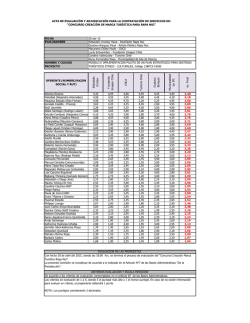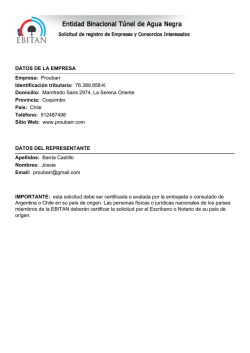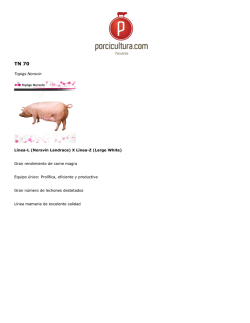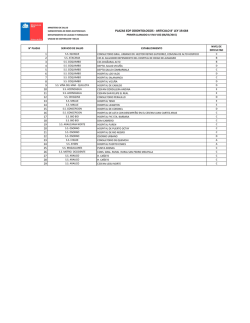
simposio 3: descubriendo el mar abierto y las islas
XXXV CONGRESO DE CIENCIAS DEL MAR – Coquimbo – La Serena, Chile SIMPOSIO 3: DESCUBRIENDO OCEÁNICAS DE CHILE. EL MAR ABIERTO Y LAS ISLAS Coordinadores: Carlos F. Gaymer & Peter Von Dassow Departamento de Biología Marina, Facultad de Ciencias del Universidad Católica del Norte, Coquimbo; ESMOI; P. Universidad Católica/IMO. [email protected] Salón Bahía 1, Martes 26, 8:30-13:00 08:30-09:15 LARGE MARINE PROTECTED AREAS–ADVANTAGES AND CHALLENGES OF GOING BIG. A. Wilhelm. 09:15-09:30: LA INVESTIGACIÓN DE IMO EN EL PACÍFICO. P. Von Dassow. 9:30-9:45: EL APORTE DE ESMOI AL CONOCIMIENTO, MANEJO Y CONSERVACIÓN DE LA ECORREGIÓN DE ISLA DE PASCUA. C.F. Gaymer 09:45-10:05: LOS TAPU ANCESTRALES PARA LA RECUPERACIÓN DE LA PESCA EN RAPA NUI. J. Aburto. 10:05-10:25: IMPACTO DE LOS REMOLINOS OCEÁNICOS DE MESOESCALA EN LOS ECOSISTEMAS INSULARES FRENTE A CHILE. S. Hormazábal. 10:30-11:00: COFFEE BREAK 11:00-11:20: CONTAMINACIÓN DEL MAR CHILENO Y DE LOS OCÉANOS DEL MUNDO CON PLÁSTICOS. M. Thiel. 11:20-11:45: DEEP SEA FAUNA. S. Thatje 11:45-12:15: REVEALING SECRETS OF PELAGIC SHARKS AND ALBACORE THROUGH ELECTRONIC TAGGING IN THE NORTHEAST PACIFIC OCEAN. S. Kohin. 12:15-13:00 DISCUSIÓN GENERAL Moderada por Carlos Gaymer y Peter Von Dassow. 4 Sociedad Chilena de Ciencias del Mar – Facultad de Ciencias del Mar, Universidad Católica del Norte XXXV CONGRESO DE CIENCIAS DEL MAR – Coquimbo – La Serena, Chile SIMPOSIO 3: DESCUBRIENDO EL MAR ABIERTO Y LAS ISLAS OCEÁNICAS DE CHILE. Coordinadores: Carlos F. Gaymer1 & Peter Von Dassow2 1 Departamento de Biología Marina, Facultad de Ciencias del Universidad Católica del Norte, Coquimbo; ESMOI ; 2P. Universidad Católica/ Instituto Milenio Oceanografía. [email protected] El mar abierto y las islas oceánicas de Chile representan la gran mayoría de nuestra zona económica exclusiva, con una importancia económica y geopolítica fundamental para el país. Sin embargo, dadas la complejidad, altos requerimientos técnicos y elevados costos que conllevan hacer investigación en esta zona, la mayor parte de los esfuerzos se han limitado a las áreas costeras, lo que se ha traducido en un déficit enorme de conocimiento sobre el funcionamiento de los ecosistemas marinos de mar abierto. A partir del 2014 y desde sus respectivos enfoques y objetivos, el Núcleo Milenio de Ecología y Manejo Sustentable de Islas Oceánicas (ESMOI) y el Instituto Milenio de Oceanografía (IMO) se están haciendo cargo del enorme desafío que significa investigar esta vasta y desconocida porción de nuestro país. A través de un esfuerzo colaborativo entre ESMOI e IMO, este simposio tiene pretende relevar la importancia que tiene para Chile la investigación del mar abierto y las islas oceánicas. Entre otros, se abordarán los siguientes temas (objetivos): 1) Chile en el contexto del Pacífico, 2) Las necesidades de investigación para el mar abierto y las islas oceánicas, y 3) Los principales desafíos que enfrentamos para la investigación. El simposio consistirá en 8 actividades: 1) 2 presentaciones de la investigación que llevan a cabo ESMOI e IMO, incluyendo aquellas áreas de investigación donde ambas instituciones están haciendo esfuerzos en conjunto. 2) 3 presentaciones en temáticas específicas de ambos centros (3 en total). 3) 2 presentaciones de investigadores extranjeros invitados que colaboran en la investigación de ESMOI e IMO. 4) 1 mesa redonda donde se discutirá sobre los 3 temas (objetivos) planteados anteriormente. Financiamiento: Iniciativa Científica Milenio, Proyectos NC120030 e IC120019, financiados por MINECOMm, EXPLORA-CONICYT, FONDECYT 1131047, NOAA 50 Sociedad Chilena de Ciencias del Mar – Facultad de Ciencias del Mar, Universidad Católica del Norte XXXV CONGRESO DE CIENCIAS DEL MAR – Coquimbo – La Serena, Chile LARGE MARINE PROTECTED AREAS–ADVANTAGES AND CHALLENGES OF GOING BIG. Wilhelm A., C.R.C. Sheppard, A.L.S. Sheppard, C.F. Gaymer, J. Parks, D. Wagner & N. Lewis. NOAA Office of National Marine Sanctuaries, Papahānaumokuākea Marine National Monument, University of Warwick, Marine Management Solutions, Universidad Católica del Norte, Núcleo Milenio de Ecología y Manejo Sustentable de Islas Oceánicas (ESMOI), Centro de Estudios Avanzados en Zonas Áridas (CEAZA). The Aichi Biodiversity Targets were designed to promote and implement the Convention on Biological Diversity (CBD) by providing a framework for action to save biodiversity and enhance its benefits for people. Specifically, Target 11 aims to protect 10% of all seas by 2020. The percentage of the world’s oceans that are protected has increased steadily in recent years, mainly due to very large marine protected areas (MPAs). 2. The issue of making major gains in achieving protection targets through ‘going big’ has brought added scrutiny to the subject ofMPAs. There is economy in scale, but several people have called into question whether going large will protect representative habitat and result in true protection, or whether it ismerely a politically expedient way for some nations to attain targets by creating paper parks, while avoiding tough conservation decisions. 3. The recent creation of large MPAs has greatly enhanced the chance of achieving global protection targets. Large areas typically contain several ecosystems and habitats that interact ecologically, and allow for more holistic conservation. The interactions between ecosystems in large MPAs occur without many of the problems associated with networks of smaller MPAs, where the connectivity between sites is often affected by human activities. 4. The disadvantages of large MPAs include difficulties of surveillance, enforcement and monitoring of vast offshore areas, as well as high total costs. While the cost per unit area may be lower for large MPAs, conducting surveillance and monitoring in such vast areas requires much more expensive technologies. 5. Large MPAs complement and add to existing management and conservation measures. Decision makers should consider designating them as one of a suite of possible protection measures. Besides greatly enhancing the chance of reaching agreed biodiversity targets, large MPAs improve the quality of conservation. LA INVESTIGACIÓN DE IMO EN EL PACÍFICO. Von Dassow P., O. Ulloa, R. Escribano, S. Hormazábal & O. Pizarro. PUC/UdeC/PUCV/IMO. Chile tiene una nueva posibilidad de enfrentar la frontera representada por el mar abierto con el nuevo buque de investigación Cabo de Hornos. En el sentido horizontal, pocas expediciones han pasado por el archipiélago Juan Fernández y por la Zona Económica Exclusiva de la Isla de Pascua e Islas Salas-y-Gómez, las cuales incluyen las aguas más claras y pobres en nutrientes del planeta. Estas regiones son también muy pobres en términos de conocimientos, siendo –en su conjunto- una de los ecosistemas menos estudiados en todo el océano mundial. Aún menos conocidas son las profundidades del mar abierto. Las pocas expediciones que han logrado explorar estas aguas más occidentales de Chile han tomado muestras casi exclusivamente en la zona epipelágica. El Instituto Milenio de Oceanografía (IMO) se enfoca en cuatros temas principales, cada uno de los cuales involucran el mar abierto. En el Tema 1, investigamos el rol de procesos de mesoescala en la transferencia de energía y materia entre la costa y el mar abierto, y entre los ámbitos epipelágicos y mesopelágicos, con consecuencias para los ecosistemas insulares. En el Tema 2, investigamos la variabilidad del océano a grandes escales, y la posibilidad de un reforzamiento de la circulación en el Pacífico Sur por el cambio climático. En el Tema 3, investigamos la adaptación de organismos y ecosistemas en un océano en cambio, incluyendo la adaptación a la ultra-oligotrofía. Finalmente, en el Tema 4, esperamos comenzar con la exploración del océano profundo en el Pacífico Sur, incluyendo las zonas mesopelágicas y batipelágicas de las islas oceánicas y montes submarinos, como así también el ecosistema hadal de la Fosa de Atacama. En este simposio revisamos el conocimiento del mar abierto y conversamos para identificar prioridades y desafíos para la investigación de esta vasta y desconocida porción de nuestro país. 51 Sociedad Chilena de Ciencias del Mar – Facultad de Ciencias del Mar, Universidad Católica del Norte XXXV CONGRESO DE CIENCIAS DEL MAR – Coquimbo – La Serena, Chile EL APORTE DE ESMOI AL CONOCIMIENTO, MANEJO Y CONSERVACIÓN DE LA ECORREGIÓN DE ISLA DE PASCUA. Gaymer C.F., G. Luna, M. Thiel, J. Sellanes, E. Acuña, M. Ramos, B. Yannicelli, D. Veliz, J. Aburto & E. Easton. Departamento de Biología Marina, Facultad de Ciencias del Universidad Católica del Norte, Coquimbo/ESMOI/CEAZA. Las islas oceánicas y los montes submarinos son de importancia estratégica para el desarrollo de Chile debido a su potencial para el turismo, la pesca y por la existencia de recursos biológicos únicos. El Núcleo Milenio de Ecología y Manejo Sustentable de Islas Oceánicas (NM-EMSIO) proporcionará las bases científicas para fortalecer una estrategia de conservación de la biodiversidad de la ecorregión de IP [incluyendo isla de Pascua (IP) y Salas y Gómez (ISG)]. Apuntamos a determinar los patrones y procesos que explican la biodiversidad de esta región e identificar los factores que la amenazan. A través de un proceso participativo se elaborará una estrategia de manejo basada en la comunidad para los recursos y ecosistemas marinos de IP. Estos objetivos se lograrán a través de tres líneas de investigación (L1 - Oceanografía y Conectividad, L2 - Ecología Marina de Islas Oceánicas, L3 - Manejo y Conservación Marina) que colaborarán estrechamente entre sí en todas las fases del MN-EMSIO. L1 estudia las condiciones oceanográficas que determinan la productividad pelágica y la conectividad de las poblaciones, usando teledetección, cruceros oceanográficos y análisis de la estructura genética de especies seleccionadas de IP e ISG. L2 describe la diversidad bentónica y pelágica, la distribución y el tamaño de las poblaciones de peces y aves marinas y las relaciones tróficas en el área de estudio. Además se estudian las amenazas a la biodiversidad (e.g. basura marina). En L3 la comunidad local participa en la recolección de datos y en la identificación de prioridades de conservación. Se desarrollarán programas específicos en los cuales (a) la comunidad reunirá datos oceanográficos y ecológicos relevantes mediante un enfoque de ciencia ciudadana y (b) los actores y tomadores de decisión utilizarán el conocimiento ecológico tradicional y datos científicos para recomendar estrategias de manejo para IP e ISG. LOS TAPU ANCESTRALES PARA LA RECUPERACIÓN DE LA PESCA EN RAPA NUI. Aburto J., C.F. Gaymer, S. Haoa & L. González. Departamento de Biología Marina, Facultad de Ciencias del Universidad Católica del Norte, Coquimbo/ESMOI; /Fundación Mata Ki Te Rangi. Easter Island (Rapa Nui) is one of the most isolated places in the world. The local Rapa Nui people have noticed an extreme decline in marine resources, which is due to the exploitation of these resources. Top-down regulations (e.g. fisherman and boat registrations and restrictions on catch-length and fishing season and location) implemented by the central fishery authorities located ~4000 km from the island do not represent the cultural heritage and interests of the Rapa Nui people. According to the local people, one of the traditional ways to protect marine resources was the taboo (or tapu in Rapa Nui) that regulated the fish harvest. Key informants were interviewed to assess what they knew about the tapu in fisheries and so that the feasibility of its implementation could be assessed based on current local conditions. The tapu that had the greatest potential impact on regulating open water resources, especially tuna, was the traditional belief that consumption of openwater fish during winter month would cause asthma. According to the interviewees, the real reason for this tapu was to protect the fish during its reproductive period, and the asthma threat was only a way to enforce the restriction. At present, tapu is not respected because of the high economic activity related to the tourism that demands fish like tuna all year around. Even though many Rapa Nui people agree that tapu re-implementation would be the best alternative to recover marine resources, people also think it is difficult to implement under modern conditions. We propose to promote a participatory process for development of a local governance structure that will use local traditions and beliefs, including tapu, to support the local decision-making process for reverting the decline of marine resources. 52 Sociedad Chilena de Ciencias del Mar – Facultad de Ciencias del Mar, Universidad Católica del Norte XXXV CONGRESO DE CIENCIAS DEL MAR – Coquimbo – La Serena, Chile IMPACTO DE LOS REMOLINOS OCEÁNICOS DE MESOESCALA EN LOS ECOSISTEMAS INSULARES FRENTE A CHILE. Hormazábal S.1, I. Andrade2, C. Morales3 & V. Combes4. 1Pontificia Universidad Católica de Valparaíso; 2IMO; 3 Universidad de Concepción; 4Oregon State University, EE.UU. En el Pacifico suroriental, los procesos oceanográficos que dan sustento a la producción biológica necesaria para mantener los ecosistemas insulares, aún son poco conocidos. Estudios recientes sugieren que la interacción de remolinos de meso y submesoescala con las islas oceánicas y montes submarinos podrían estar jugando un rol importante en la variabilidad estacional e interanual de la productividad primaria. En este trabajo, resultados de modelos, combinados con información de clorofila-a y altimetría satelital, además de información proveniente de cruceros oceanográficos, fueron utilizados para determinar las principales características de los remolinos de mesoescala y su impacto en los ecosistemas insulares en la región del Pacífico suroriental. Los resultados provenientes de un modelo numérico de alta resolución, muestran una asimetría entre el campo de remolinos superficiales y subsuperficiales. Los remolinos superficiales que giran en sentido ciclónico son más frecuentes que giran en sentido anticiclónico. Dentro de los remolinos subsuperficiales, denominados ITE's (Intrathermocline Eddies), los remolinos anticiclónicos son más frecuentes que los ciclónicos y disminuyen su transporte hacia el oeste durante los eventos El Niño. En general los remolinos de mesoescala son estructuras recurrentes en las cercanías de las islas. La interacción de los remolinos de mesoescala con las islas oceánicas pueden generar incrementos significativos de clorofila-a, los que pueden alcanzar valores tres veces mayores que el observado en las aguas oceánicas adyacentes. En los sistemas de islas oceánicas, estelas con alta concentración de clorofila se vinculan con la formación y desprendimiento de remolinos de submesoescala, al parecer forzados en parte por el viento local y los remolinos de mesoescala. Estos incrementos de clorofila podrían tener fuertes implicancias biológicas, especialmente durante los periodos de baja concentración de clorofila a escala regional. CONTAMINACIÓN DEL MAR CHILENO Y DE LOS OCÉANOS DEL MUNDO CON PLÁSTICOS. Thiel, M.1, G. Luna1, D. Miranda2 & V. Hidalgo Ruz2. 1Departamento de Biología Marina, Facultad de Ciencias del Universidad Católica del Norte, Coquimbo; 2Magister en Ciencias del Mar M. Recursos Costeros, Facultad de Ciencias del Universidad Católica del Norte, Coquimbo. Plastic pollution is ubiquitous throughout the marine environment, yet estimates of the global abundance and weight of floating plastics have lacked data, particularly from the Southern Hemisphere and remote regions. Here we report an estimate of the total number of plastic particles and their weight floating in the world's oceans from 24 expeditions (2007–2013) across all five sub-tropical gyres, costal Australia, Bay of Bengal and the Mediterranean Sea conducting surface net tows (N = 680) and visual survey transects of large plastic debris (N = 891). Using an oceanographic model of floating debris dispersal calibrated by our data, and correcting for wind-driven vertical mixing, we estimate a minimum of 5.25 trillion particles weighing 268,940 tons. When comparing between four size classes, two microplastic <4.75 mm and meso- and macroplastic >4.75 mm, a tremendous loss of microplastics is observed from the sea surface compared to expected rates of fragmentation, suggesting there are mechanisms at play that remove <4.75 mm plastic particles from the ocean surface. As in the other oceanic gyres, in the S Pacific subtropical gyre, micro- and macro-plastics accumulate in the center of the gyre, where the two islands Salas & Gomez and Rapa Nui are located. Several seabird species inhabit these islands, and first observations suggest impacts of the high plastic load on seabirds. These impacts maybe direct, by entanglement with larger items or ingestion of smaller plastics. Whether indirect impacts, e.g. by plastic uptake via their prey fishes, also affects seabirds will have to be investigated in future studies. Data on the types of macroplastics arriving on Rapa Nui, collected with the help of schoolchildren from Rapa Nui suggest that a large fraction of the plastic input comes from the open ocean fisheries. Stronger international efforts are required to reduce this input. 53 Sociedad Chilena de Ciencias del Mar – Facultad de Ciencias del Mar, Universidad Católica del Norte XXXV CONGRESO DE CIENCIAS DEL MAR – Coquimbo – La Serena, Chile DEEP SEA FAUNA. Thatje, S. Ocean and Earth Science, University of Southampton, England, U.K. The past decades have seen a tremendous boost in the availability of technology, which has revolutionized the ways we can improve our understanding of the deep ocean. Here, I present a very personal view of deep-sea research at the onset of the 21st century, by presenting an overview of the challenges – and opportunities – the scientific community faces when attempting to understand better the patterns and processes governing life in 70% of the global ocean. As an ecologist and evolutionary biologist, I am particularly interested in what drives the diversity of organisms in the deep ocean, and how the environment has shaped species over evolutionary period of time; past, present, and future. I present case studies from national and international collaborations, covering different temporal and spatial scales of deep-sea research, including some exciting recent developments and discoveries, which relied on international collaboration in order to mobilize the necessary resources, both in technology and human expertise. The deep ocean is one of the last frontiers to the exploitation by man; the research community does, therefore, take responsibility for current and future man-made activities in the deep-sea. I present a brief overview of a European initiative (MIDAS FP7 project), which currently engages with this process, and within an international context. REVEALING SECRETS OF PELAGIC SHARKS AND ALBACORE ELECTRONIC TAGGING IN THE NORTHEAST PACIFIC OCEAN THROUGH Kohin S.1, H. Dewar1, J. Childers1, B. Block2, J. Wraith1, O. Sosa-Nishizaki3, N. Nasby-Lucas1, M. Kinney1, O. Snodgrass1, J. King4, D. Holts1, J. Hyde1 & R. Vetter1. 1NOAA Fisheries Southwest Fisheries Science Center, La Jolla CA, USA. 2 Stanford University, Hopkins Marine Station, Pacific Grove CA, USA. 3 Centro de Investigación Científica y de Educación Superior de Ensenada, Ensenada BC, México. 4 Fisheries and Oceans Canada, Pacific Biological Station, Nanaimo BC, Canada The NOAA Southwest Fisheries Science Center has been involved in electronic tagging studies of pelagic sharks including blue (Prionace glauca), shortfin mako (Isurus oxyrinchus), basking (Cetorhinus maximus) and thresher (Alopias vulpinus) sharks and albacore tuna (Thunnus alalunga) since the early 2000s. Blue and shortfin mako sharks are being studied as part of the Tagging of Pelagic Predators (TOPP) program, while several academic, industry and governmental collaborators have contributed to studies of the other species. Tagging methodologies vary across species and have been refined over time to improve tag retention and data reporting. For pelagic sharks, popoff satellite archival (PSAT), fast GPS transmitting PSAT (GPS-PSAT) and/or satellite-linked radio transmitting (SPOT) tags are used to examine horizontal and vertical behavior. To date, 83 blue, 99 shortfin mako, 4 basking and 20 thresher sharks have been successfully tracked using one or more satellite tags (deployments of 9 to 1025 days). Each species shows distinct behaviors. Thresher sharks remain relatively coastal off California and Baja California and spend most of their time in epipelagic waters above the thermocline, whereas blue and shortfin makos are wider ranging, moving throughout the Northeast Pacific from the North America West Coast out toward the Hawaiian Islands. Blue sharks routinely make vertical excursions to depths greater than 200 m during the day, while shortfin makos spend a greater amount of time in the top 60 m. Individual basking sharks showed regional variation in behavior remaining close to the surface along the coast while transitioning to deeper swimming modes and avoiding surface waters when offshore. For albacore, archival tags that record depth, temperature and light are deployed in the peritoneal cavity and data are recovered only upon recapture. Twenty-nine tagged albacore have been recaptured after 25-1035 days at liberty. Light-based location estimates show that many of the tagged albacore made extensive migrations from the U.S. West Coast to Central and Western Pacific waters or along the coast of Baja Mexico. Seasonal and spatial movements of all tagged fish have been examined with respect to oceanographic conditions in order to understand habitat use patterns and infer foraging hotspots and migratory corridors. These studies are some of the first to highlight both diversity and niche partitioning among co-occurring large pelagic fish in the Eastern Pacific Ocean. 54 Sociedad Chilena de Ciencias del Mar – Facultad de Ciencias del Mar, Universidad Católica del Norte
© Copyright 2024



